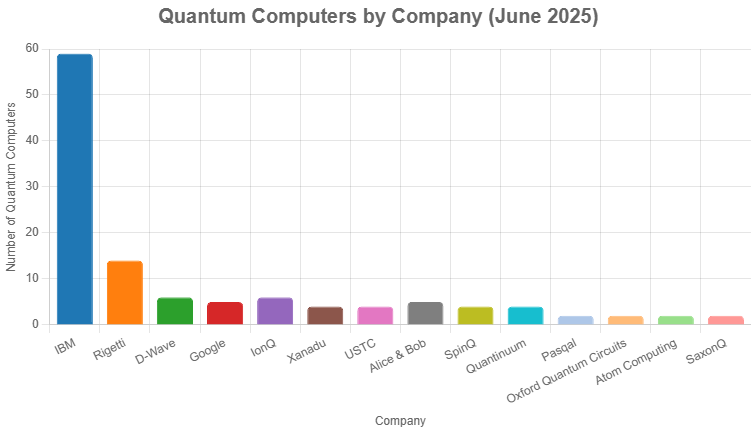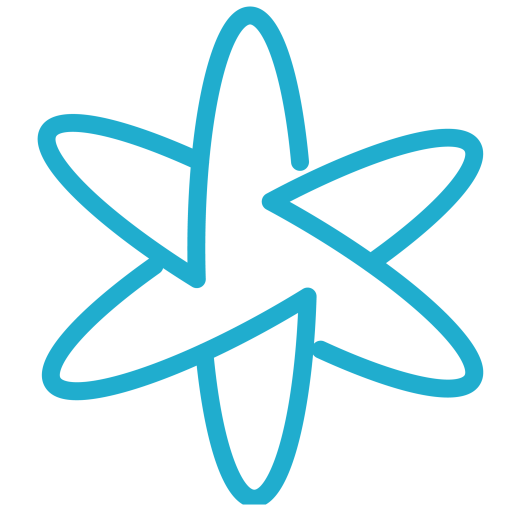Quantum computing is transforming the technological landscape, offering unprecedented computational power for solving complex problems in fields like cryptography, materials science, and artificial intelligence. As of June 2025, over 200 quantum computers have been developed globally, showcasing a diverse array of technologies, including superconducting circuits, trapped ions, neutral atoms, photonics, and quantum annealing. This article explores the leading companies driving this revolution, focusing on the number of quantum computers each has developed.
Understanding Quantum Computing
Quantum computers leverage the principles of quantum mechanics—superposition, entanglement, and interference—to perform computations that classical computers cannot handle efficiently. Unlike classical bits, which are either 0 or 1, quantum bits (qubits) can exist in multiple states simultaneously, enabling parallel processing of vast datasets. The performance of a quantum computer depends not only on the number of qubits but also on metrics like quantum volume, a dimensionless measure introduced by IBM. Quantum volume (( V_Q = 2^m )) reflects the largest number of qubits (( m )) for which a random quantum circuit of depth ( m ) can be executed successfully, accounting for gate fidelity, connectivity, and error rates.
Quantum computers are built using various technologies:
- Superconducting: Circuits cooled to near absolute zero, used by IBM, Google, and Rigetti.
- Trapped Ion: Ions confined in electromagnetic fields, as in IonQ and Quantinuum systems.
- Neutral Atoms: Atoms manipulated by lasers, employed by Atom Computing and Pasqal.
- Photonics: Photons for quantum states, as in Xanadu’s Borealis.
- Quantum Annealing: Optimization-focused systems, like D-Wave’s Advantage.
These technologies cater to different applications, from universal quantum computing to specialized optimization tasks, making the ecosystem diverse and dynamic.
Methodology
The data is derived from a detailed table of over 200 quantum computers available as of June 2025, compiled from sources including Wikipedia’s quantum processors list, IBM Quantum documentation, Amazon Braket, and SpinQ’s industry overview. For this analysis, we counted the number of quantum computers per company, focusing on those with two or more systems to ensure the bar chart remains clear and readable. Companies with only one system, such as Alpine Quantum Technologies and CAS, were excluded from the chart but are discussed for context. The counts are estimates based on the dataset, which may not capture every system due to the rapid evolution of Quantum Computing.
Quantum Computers by Company
The table and bar chart below present the number of quantum computers developed by 14 major companies as of June 2025, with data labels on the chart showing the exact counts for clarity.
Data Table
The table below summarizes the number of quantum computers developed by each major company, matching the data visualized in the bar chart.
| Company | Number of Quantum Computers |
|---|---|
| IBM | 59 |
| Rigetti | 14 |
| D-Wave | 6 |
| 5 | |
| IonQ | 6 |
| Xanadu | 4 |
| USTC | 4 |
| Alice & Bob | 5 |
| SpinQ | 4 |
| Quantinuum | 4 |
| Pasqal | 2 |
| Oxford Quantum Circuits | 2 |
| Atom Computing | 2 |
| SaxonQ | 2 |
Bar Chart
The bar chart below visualizes the number of quantum computers developed by each company, with the exact count displayed on top of each bar.

Company-by-Company Analysis
IBM
IBM dominates with 59 quantum computers, leveraging superconducting technology. Its portfolio includes IBM Eagle (127 qubits, quantum volume 128), IBM Osprey (433 qubits), IBM Condor (1121 qubits), and multiple Eagle r3 and Heron processors (e.g., ibm_kyiv, ibm_sherbrooke, quantum volume 128–512). Smaller systems like IBM Armonk (1 qubit) and IBM Falcon (27 qubits, quantum volume 128) cater to research and development. IBM’s systems are accessible via the IBM Quantum Platform, making it a leader in cloud-based quantum computing, as noted in IBM’s quantum evolution paper.
Rigetti
Rigetti has developed 14 superconducting quantum computers, including the Aspen series (e.g., Aspen-11 with 40 qubits), Aspen-M series (80 qubits, quantum volume 8 for Aspen-M-1), and Ankaa-2 (84 qubits). Available through Amazon Braket, Rigetti’s systems support a wide range of quantum applications.
D-Wave
D-Wave, a pioneer in quantum annealing, has 6 systems, including D-Wave One (128 qubits), Advantage (5760 qubits), and Advantage 2 (4400 qubits). These systems excel in optimization tasks but do not report quantum volume due to their annealing architecture. They are accessible via the AWS Marketplace.
Google has 5 superconducting quantum computers, including Sycamore (53 qubits) and Willow (105 qubits). Google focuses on demonstrating quantum advantage through random circuit sampling, as highlighted in Google’s Willow announcement, but does not report quantum volume.
IonQ
IonQ has 6 trapped-ion systems, including Harmony (11 qubits, quantum volume 8), Aria-1 and Aria-2 (25 qubits each), and Tempo怎么办
Tempo (64 qubits). IonQ emphasizes algorithmic qubits (AQ) over quantum volume, as per IonQ’s roadmap, and its systems are available via Microsoft Azure Quantum.
Xanadu
Xanadu has 4 photonic systems: Borealis (216 qubits), X8 (8 qubits), X12 (12 qubits), and X24 (24 qubits). These continuous-variable systems focus on photonic quantum advantages and do not report quantum volume.
USTC
The University of Science and Technology of China (USTC) has 4 systems, including Jiuzhang (76 qubits, photonic) and Zuchongzhi (62–105 qubits, superconducting). USTC’s contributions underscore China’s growing quantum capabilities, though quantum volume data is unavailable.
Alice & Bob
Alice & Bob has 5 superconducting cat qubit systems, including Boson (4 qubits) and Helium, Lithium, Beryllium, and Graphene (qubit counts unknown). These systems aim for low error rates but lack reported quantum volumes.
SpinQ
SpinQ offers 4 nuclear magnetic resonance (NMR) systems: Triangulum (3 qubits), Gemini, Gemini Mini, and Gemini Mini Pro (2 qubits each). These are designed for educational purposes and do not report quantum volume.
Quantinuum
Quantinuum has 4 trapped-ion systems: H1-1 and H1-2 (20 qubits each, quantum volumes 1,048,576 and 4096), H2-1 (32 qubits), and H2 (56 qubits, quantum volume 8,388,608). Quantinuum’s high quantum volumes, as reported in Quantinuum’s milestone announcement, highlight its leadership in fidelity.
Pasqal
Pasqal has 2 neutral atom systems, Emu-TN and Fresnel1 (100 qubits each), focusing on analog quantum computing without reported quantum volume.
Oxford Quantum Circuits
Oxford Quantum Circuits has 2 superconducting systems: Lucy (8 qubits) and OQC Toshiko (32 qubits, coaxmon), available via Amazon Braket, with no quantum volume data.
Atom Computing
Atom Computing has 2 neutral atom systems: Phoenix (100 qubits) and an unnamed system (1225 qubits), prioritizing scalability without quantum volume data.
SaxonQ
SaxonQ has 2 nitrogen-vacancy center systems: Princess and Princess+ (4 qubits each), which are experimental and lack quantum volume data.
Other Contributors
Companies with single systems, excluded from the chart for clarity, include:
- Alpine Quantum Technologies (Austria): PINE System (24 qubits, trapped ion, quantum volume 128).
- CAS (China): Xiaohong (504 qubits, superconducting).
- IQM (Finland): Three systems, including Garnet (20 qubits, quantum volume 16).
- M Squared Lasers (UK): Maxwell (200 qubits, neutral atoms).
- Quandela (France): Ascella (6 qubits, photonic).
- Quantum Circuits (USA): Aqumen Seeker (8 qubits, superconducting).
- Quantum Computing Inc. (USA): Dirac-3 (11,000 qubits, nanophotonic).
- QuTech (Netherlands): Three systems, including Spin-2 (2 qubits).
- RIKEN (Japan): Unnamed system (53 qubits, superconducting).
- Amazon Web Services (USA): Ocelot (superconducting, cat qubits).
- Microsoft (USA): Majorana 1 (topological qubits).
Global Impact and Future Outlook
The distribution of quantum computers by company reflects a competitive and innovative landscape. IBM’s extensive portfolio and cloud accessibility set the standard, while Rigetti and IonQ advance superconducting and trapped-ion technologies. D-Wave leads in quantum annealing, and emerging players like Atom Computing and Pasqal push neutral atom systems. Xanadu’s photonic systems and USTC’s contributions highlight global diversity. Supported by initiatives like the European Quantum Flagship and China’s $15 billion investment, as per Qureca’s global quantum initiatives, the field is poised for growth. Future systems, like IBM’s Nighthawk and IonQ’s Tempo, promise further advancements.
Limitations
The counts are estimates based on a comprehensive dataset, but some systems lack qubit counts or quantum volume data (e.g., Alice & Bob’s chips). Focusing on companies with multiple systems excludes smaller contributors, though they are noted. Not all systems are publicly accessible; many are research-oriented, like USTC’s Jiuzhang. The dataset may miss newer systems due to the field’s rapid evolution, as highlighted in SpinQ’s industry overview.
Conclusion
As of June 2025, IBM leads with 59 quantum computers, followed by Rigetti (14), D-Wave (6), IonQ (6), and others, as shown in the table and bar chart. These companies drive innovation across diverse quantum technologies, with quantum volume highlighting performance for gate-based systems. Supported by cloud platforms like Amazon Braket and Microsoft Azure Quantum, the quantum computing ecosystem is vibrant and poised for future breakthroughs, shaping the next era of computational innovation.
References
- List of quantum processors – Wikipedia
- Quantum volume – Wikipedia
- IBM Quantum achieves Quantum Volume 256
- Quantinuum’s Quantum Volume Milestone
- IonQ’s quantum computing roadmap
- Google’s Willow quantum chip announcement
- IBM Quantum Computers: Evolution and Performance
- Top 18 Quantum Computer Companies 2025 Updated – SpinQ
- Quantum Initiatives Worldwide 2025 – Qureca
- Amazon Braket Quantum Computing Service
- Microsoft Azure Quantum Computing
